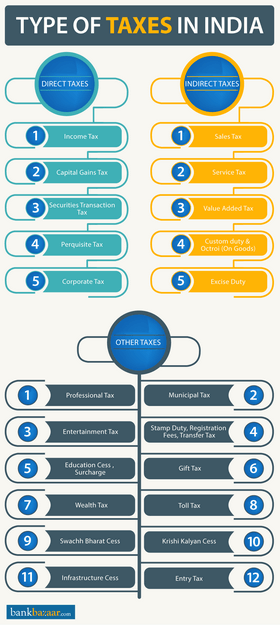কৰৰ প্ৰকাৰসমূহ
কৰসমূহ দুটা ভিন্ন প্ৰকাৰৰ, প্ৰত্যক্ষ আৰু পৰোক্ষ কৰ. এই কৰসমূহ কাৰ্যকৰী কৰাৰ পদ্ধতিত পাৰ্থক্য আহে. কিছুমান আপুনি প্ৰত্যক্ষভাৱে পৰিশোধ কৰে, যেনে ভয়ানক আয় কৰ, সম্পদ কৰ, কৰ্পৰেট কৰ ইত্যাদি, য'ত আন সমূহ পৰোক্ষ কৰ, যেনে মূল্য সংযোজিত কৰ, সেৱা কৰ, বিক্ৰী কৰ ইত্যাদি.
1. প্ৰত্যক্ষ কৰ
2. পৰোক্ষ কৰ
কিন্তু, এই দুটা পৰম্পৰাগত কৰৰ লগতে, এইবোৰ হৈছে অন্য কৰসমূহ যিটো কেন্দ্ৰীয় চৰকাৰে এটা বিশেষ কাৰ্যসূচীপত্ৰ সেৱা কৰিবলৈ কাৰ্যকৰী কৰিছে. ‘অন্যান্য কৰসমূহ প্ৰত্যক্ষ আৰু পৰোক্ষ দুয়োটা কৰতে আৰোপ কৰা হয় যেনে শেহতীয়াকৈ প্ৰচলন কৰা স্বচ্ছ ভাৰত চেছ কৰ, কৃষি কল্যাণ চেছ কৰ আৰু আন্তঃগাঁথনি চেছ কৰ.
1. প্ৰত্যক্ষ কৰ
আগতে উল্লেখ কৰাৰ দৰে প্ৰত্যক্ষ কৰ হৈছে আপুনি পৰিশোধ কৰা কৰ. এই কৰসমূহ এটা একক বা এজন ব্যক্তিৰ ওপৰত পোনপটীয়াকৈ আৰোপ কৰা হয় আৰু আন কাৰোলৈ স্থানান্তৰ কৰিব নোৱাৰি. এই প্ৰত্যক্ষ কৰক অতিক্ৰম কৰা এটা সমিতি হৈছে চেন্ট্ৰেল ব'ৰ্ড অফ ডাইৰেক্ট টেক্স (চিবিডিটি) যিটো ৰাজহ বিভাগৰ এটা অংশ. ই ইয়াৰ কৰ্তব্যৰ লগত সহায় কৰিবলৈ, প্ৰত্যক্ষ কৰৰ বিভিন্ন দিশবোৰ শাসন কৰা বিভিন্ন আইনৰ সমৰ্থনত.
এই কাৰ্য্যসমূহৰ কিছুমান:
· আয়কৰ আইন:
ইয়াক 1961ৰ আই.টি অধিনিয়ম বুলিও জনা যায় আৰু ভাৰতত আয় কৰক পৰিচালনা কৰা নিয়মসমূহ স্থাপন কৰে. আয়, যি এই আইনত কৰ আদায় কৰে, এক ব্যৱসায়, এটা ঘৰ বা সম্পত্তি মালিক হৈ, বিনিয়োগৰ পৰা প্ৰাপ্ত লাভ আৰু দৰমহা ইত্যাদিৰ দৰে উৎসৰ পৰা আহিব পাৰে. এইখন সেইখন আইন যি ফিক্সড ডিপ'জিট বা এক জীৱন বীমা প্ৰিমিয়ামৰ ওপৰত কিমান কৰ লাভ হ'ব সেইটো নিৰ্ধাৰণ কৰে. এইটো আইন যি আপুনি আপোনাৰ আয়ৰ কিমান অংশ বিনিয়োগৰ মাধ্যমেৰে সঞ্চয় কৰিব পাৰে আৰু আয় কৰৰ কোনটো শ্লেব হ'ব সেইটো নিৰ্ধাৰণ কৰে.
· ধন কৰ আইন:
The Wealth Tax Act was enacted in 1951 and is responsible for the taxation related to the net wealth of an individual, a company or a Hindu Unified Family. The simplest calculation of wealth tax was that if the net wealth exceeded Rs. 30 lakhs, then 1% of the amount that exceeded Rs. 30 lakhs was payable as tax. It was abolished in the budget announced in 2015. It has since been replaced with a surcharge of 12% on individuals that earn more than Rs. 1 crore per annum. It is also applicable to companies that have a revenue of over Rs. 10 crores per annum. The new guidelines drastically increased the amount the government would collect in taxes as opposed the amount they would collect through the wealth tax.
· Gআই.এফ.টি কৰ আইন:
The Gift Tax Act came into existence in 1958 and stated that if an individual received gifts, monetary or valuables, as gifts, a tax was to be to be paid on such gifts. The tax on such gifts was maintained at 30% but it was abolished in 1998. Initially if a gift was given, and it was something like property, jewellery, shares etc. it was taxable. According to the new rules gifts given by family members like brothers, sister, parents, spouse, aunts and uncles are not taxable. Even gifts given to you by the local authorities is exempt from this tax. How the tax works now is that if someone, other than the exempt entities, gifts you anything that exceeds a value of Rs. 50,000 then the entire gift amount is taxable.
· ব্যয় কৰ আইন:
এইখন হৈছে এনে এক আইন যি 1987ত প্ৰৱৰ্তিত হৈছিল আৰু আপুনি, এগৰাকী ব্যক্তিৰূপে, এখন হোটেল বা এখন ৰেষ্টুৰেণ্টত সেৱা উপলব্ধ কৰাৰ সময়ত হ'ব পৰা ব্যয়ৰ লগত লেনদেন কৰে. ই জম্মু আৰু কাশ্মীৰৰ বাহিৰে সকলো ভাৰততে প্ৰযোজ্য. ইয়াত কোৱা হৈছে যে যদি এখন হোটেলৰ ক্ষেত্ৰত আৰু এখন ৰেষ্টুৰেণ্টত কৰা সকলো ব্যয়ৰ ক্ষেত্ৰত যদি সেইবোৰে 3,000 টকাতকৈ অধিক হয় তেন্তে ই আইনৰ অধীনত কিছুমান ব্যয় পৰিশোধযোগ্য হয়.
· সুত কৰ আইন:
1974ৰ সুতৰ কৰ আইনে কিছুমান নিৰ্দিষ্ট পৰিস্থিতিত উপাৰ্জন কৰা সুতৰ ওপৰত পৰিশোধ কৰিবলগীয়া কৰৰ সৈতে সম্বন্ধিত. আইনখনৰ অন্তিম সংশোধনত ইয়াক কোৱা হৈছিল যে এই আইন মাৰ্চ 2000ৰ পিছত উপাৰ্জন কৰা সুতৰ ওপৰত প্ৰয়োগিত নহয়.
তলত সকলো ভিন্ন প্ৰকাৰৰ প্ৰত্যক্ষ কৰৰ কিছুমান উদাহৰণ প্ৰদান কৰা হৈছে:

প্ৰত্যক্ষ কৰৰ উদাহৰণ
এইসমূহ হৈছে আপুনি পৰিশোধ কৰা কিছুমান প্ৰত্যক্ষ কৰ
a) আয় কৰ:
This is one of the most well-known and least understood taxes. It is the tax that is levied on your earning in a financial year. There are many facets to income tax, such as the tax slabs, taxable income, tax deducted at source (TDS), reduction of taxable income, etc. The tax is applicable to both individuals and companies. For individuals, the tax that they have to pay depends on which tax bracket they fall in. This bracket or slab determines the tax to be paid based on the annual income of the assessee and ranges from no tax to 30% tax for the high income groups.
চৰকাৰে বিভিন্ন গোটৰ লোকৰ বাবে বিভিন্ন কৰ শ্লেব নিৰ্ধাৰণ কৰিছে, সাধাৰণ কৰদাতা, জেষ্ঠ নাগৰিক (60 ৰ পৰা 80ৰ মাজৰ বয়সৰ লোকসকল), আৰু অতি জেষ্ঠ নাগৰিক ( 80ৰ অধিক বয়সৰ লোকসকল).
b) মূলধন লাভ কৰ:
This is a tax that is payable whenever you receive a sizable amount of money. It could be from an investment or from the sale of a property. It is usually of two types, short term capital gains from investments held for less than 36 months and long term capital gains from investments held for longer than 36 months. The tax applicable for each is also very different since the tax on short term gains is calculated based in the income bracket that you fall in and the tax on long term gains is 20%. The interest thing about this tax is that the gain doesn’t always have to be in the form of money. It could also be an exchange in kind in which case the value of the exchange will be considered for taxation.
c) চিকিউৰিটি লেনেদেন কৰ:
এইটো কোনো গোপনীয়তা নহয় যে যদি আপুনি ষ্টক মাৰ্কেটত কিদৰে সঠিকভাৱে ট্ৰেড কৰে জানে আৰু প্ৰতিভূতিৰ ব্যৱসায় কৰে, আপুনি এক পৰ্য্যাপ্ত পৰিমাণৰ ধন উপাৰ্জন কৰিব পাৰে. এইটোও আয়ৰ এটা উত্স কিন্তু ইয়াৰ নিজৰ কৰ আছে যাক চিক্যুৰিটি ট্ৰাঞ্জাংষ্যন কৰ বুলিও জনা যায়. এই কৰটো এনেদৰে আৰোপ কৰা হয় যে শ্বেয়াৰৰ দামত কৰ সংযোগ কৰি. ইয়াৰ অৰ্থ এইটো যে প্ৰতিবাৰ আপুনি শ্বেয়াৰ ক্ৰয় বা বিক্ৰী কৰোঁতে, এই কৰ পৰিশোধ কৰে. ভাৰতীয় ষ্টক এক্সচেঞ্জত ট্ৰেড কৰা সকলো চিক্যুৰিটিয়ে তেওঁলোকৰ লগত এই কৰ সংলগ্ন কৰিছে.
d)পৰিলব্ধ কৰ:
Perquisites are all the perks or privileges that employers may extend to employees. These privileges may include a house provided by the company or a car for your use, given to you by the company. These perks are not just limited to big compensation like cars and houses, they can even include things like compensation for fuel or phone bills. How this tax is levied is by figuring out how that perk has been acquired by the company or used by the employee. In the case of cars, it may be so that a car provided by the company and used for both personal and official purposes is eligible for tax whereas a car used only for official purposes is not.
ঙ) কৰ্প'ৰেট কৰ:
Corporate tax is the income tax that is paid by companies from the revenue they earn. This tax also comes with a slab of its own that decides how much tax the company has to pay. For example a domestic company, which has a revenue of less than Rs. 1 crore per annum, won’t have to pay this tax but one that has a revenue of more than Rs. 1 crore per annum will have to pay this tax. It is also referred to as a surcharge and is different for different revenue brackets. It is also different for international companies where the corporate tax may be 41.2% if the company has a revenue of less than Rs. 10 million and so on.
চাৰিটা ভিন্ন প্ৰকাৰৰ কৰ্প'ৰেট কৰ আছে. সেইসমূহ হৈছে:
· ন্যূনতম বৈকল্পিক কৰ:
ন্যূনতম বৈকল্পিক কৰ, বা এম.এ.টি, হৈছে মূলতে কোম্পানীসমূহক এক ন্যূনতম কৰ আদায় কৰাবৰ বাবে আয়কৰ বিভাগৰ এক উপায়, যি বৰ্তমান 18.5%.. আয়কৰ আইনৰ ধাৰা 115জে.এ. প্ৰৱৰ্তনৰ জৰিয়তে এই প্ৰকাৰৰ কৰ প্ৰয়োগলৈ অনা হৈছিল. অৱশ্যে, আন্তঃগাঁথনি আৰু শক্তি খণ্ডত জড়িত কোম্পানীসমূহক এম.এ.টি পৰিশোধৰ পৰা ৰেহাই দিয়া হয়.
এটা কোম্পানীয়ে যেতিয়া এম.এ.টি পৰিশোধ কৰে, ই কিছুমান নিৰ্দিষ্ট চৰ্তসাপেক্ষে পৰৱৰ্তী পাঁচ বছৰ সময়কালৰ বাবে নিয়মিতভাৱে পৰিশোধনীয় কৰৰ বিৰূদ্ধে পৰিশোধক আগবঢ়াই নিব আৰু সামঞ্জস্য কৰিব.
· গৌণ লাভ কৰ:
গৌণ লাভ কৰ, বা এফ.বি.টি. এনে এক কৰ আছিল যিটো নিজৰ কৰ্মচাৰিক প্ৰদান কৰা প্ৰায় প্ৰতিটো গৌণ লাভতে আৰোপ কৰা হৈছিল. এই কৰত, বহুতো দিশ লোৱা হৈছিল. তেওঁলোকৰ কেইটামান হৈছে:
i) ভ্ৰমণ (এল.টি.এ), কৰ্মচাৰী কল্যাণ, আবাস আৰু বিনোদৰ ওপৰত নিয়োগকৰ্তাৰ ব্যয়.
ii) এগৰাকী নিয়োগকৰ্তাৰ দ্বাৰা প্ৰদান কৰা কোনো নিয়মিত যাতায়ত বা যাতায়ত সম্পৰ্কিয় ব্যয়.
iii) এক প্ৰমাণিত অৱসৰ প্ৰাপ্ত হোৱাৰ পিছৰ ফাণ্ডলৈ নিয়োগকৰ্তাৰ অৱদান.
iv) নিয়োগকৰ্তাৰ ষ্টক বিকল্প যোজনা (ই.এছ.অ.পি).
1 এপ্ৰিল, 2005. ৰ পৰা ভাৰত চৰকাৰৰ তত্বাৱধানত এফ.বি.টি আৰম্ভ কৰা হৈছিল. তথাপিও, 2009 কেন্দ্ৰীয় বাজেট অধিবেশনৰ সময়ত তত্কালীন বিত্তমন্ত্ৰী প্ৰণৱ মূখাৰ্জীয়ে 2009ত কৰ বাতিল কৰিছিল.
· লাভাংশ বিতৰণ কৰ:
2007ৰ কেন্দ্ৰীয় বাজেটৰ শেষত লাভাংশ বিতৰণ কৰ সূচনা কৰা হৈছিল. এইটো মূলত কোম্পানীসমূহে তেওঁলোকৰ বিনিয়োগকাৰীক পৰিশোধ কৰা লাভাংশৰ ওপৰত ধাৰ্য্য কৰা কৰ হয়. এই কৰটো এগৰাকী বিনিয়োগকাৰীয়ে তেওঁলোকৰ বিনিয়োগৰ পৰা প্ৰাপ্ত কৰা মুঠ বা শুদ্ধ আয়ৰ ওপৰত প্ৰযোজ্য. বৰ্তমান, ডিডিটি হাৰ 15%ত আছে.
· অধিকোষ নগদ লেনদেন কৰ:
অধিকোষ নগদ লেনদেন হৈছে ভাৰত চৰকাৰ দ্বাৰা পৰিত্যাগ কৰা আন এটা কৰৰ প্ৰকাৰ. এই কৰ বিধ 2005-2009 সঞ্চালিত হৈছিল তেতিয়া তত্কালীন বিত্ত মন্ত্ৰী প্ৰণৱ মূখাৰ্জীয়ে কৰটো সমাপ্ত কৰিছিল. এই কৰটোৱে পৰামৰ্শ দিছিল যে প্ৰতিটো বেংকৰ লেনদেনত (ডেবিট বা ক্ৰেডিট) 0.1% হাৰত কৰ আৰোপ কৰা হ'ব.
2. পৰোক্ষ কৰ:
সংজ্ঞা অনুসৰি, পৰোক্ষ কৰ হৈছে সেই কৰসমূহ যিসমূহ সামগ্ৰী বা সেৱাৰ ওপৰত আৰোপ কৰা হয়. তেওঁলোকে প্ৰত্যক্ষ কৰৰ পৰা পৃথক হয় কিয়নো তেওঁলোক এনে এজন ব্যক্তিৰ ওপৰত ধাৰ্য্য কৰা নহয় যি তেওঁলোকক প্ৰত্যক্ষভাৱে চৰকাৰক পৰিশোধ কৰে, ইয়াৰ পৰিৱৰ্তে তেওঁলোক সামগ্ৰীৰ ওপৰত ধাৰ্য্য কৰা হয় আৰু এজন মধ্যস্থতাকাৰীৰ দ্বাৰা সংগ্ৰহ কৰা হয়, সামগ্ৰী বিক্ৰী কৰা ব্যক্তি. পৰোক্ষ কৰৰ পৰোক্ষ কৰৰ সবাতোকৈ সাধাৰণ উদাহৰণ হ'ব পাৰে ভেট (মূল্য সংযোজিত কৰ), আমদানি কৰা সামগ্ৰীৰ ওপৰত কৰ, বিক্ৰী কৰ ইত্যাদি. এই কৰসমূহ সেৱা বা সামগ্ৰীৰ মূল্যত যোগ কৰি আৰোপ কৰা হয় যি সামগ্ৰীৰ দাম বৃদ্ধি কৰিব বিচাৰে.
পৰোক্ষ কৰৰ উদাহৰণ:
এইসমূহ হৈছে আপুনি পৰিশোধ কৰা কিছুমান সাধাৰণ পৰোক্ষ কৰ.
a) চেলচ্ টেক্স:
নাম অনুসাৰে, বিক্ৰী কৰ হৈছে এটা কৰ যিটো এটা সামগ্ৰীৰ বিক্ৰীৰ ওপৰত ধাৰ্য্য কৰা হয়. এই সামগ্ৰীটো এনে কিবা হ'ব পাৰে যিটো ভাৰতত উত্পাদন হৈছিল বা আমদানি কৰা হৈছিল আৰু প্ৰদান কৰা সেৱাসমূহকো অন্তৰ্ভুক্ত কৰিব পাৰে. এই কৰটো সামগ্ৰীৰ বিক্ৰেতাৰ ওপৰত ধাৰ্য্য কৰা হয় যি ইয়াক সেই সামগ্ৰীৰ দামত বিক্ৰী কৰ সৈতে ক্ৰয় কৰা ব্যক্তিলৈ স্থানান্তৰ কৰে. এই কৰ সীমাবদ্ধতা এইয়ে যে এটা নিৰ্দিষ্ট সামগ্ৰীৰ বাবে মাত্ৰ এবাৰহে আৰোপ কৰিব পাৰি, যাৰ অৰ্থ এইয়ে যে যদি সামগ্ৰী দ্বিতীয়বাৰ বিক্ৰী কৰা হয়, ইয়াৰ ওপৰত বিক্ৰী কৰ প্ৰয়োগ কৰিব নোৱাৰিব.
মূলতে, দেশৰ সকলো ৰাজ্যই তেওঁলোকৰ নিজা বিক্ৰী কৰ আইন অনুসৰণ কৰে আৰু এক শতাংশ স্বদেশী মাচুল লয়. ইয়াৰ উপৰিও, কিছুমান ৰাজ্যই টাৰ্ণঅভাৰ কৰ, ক্ৰয় কৰ, কৰ্ম লেনেদেন কৰ আৰু এনে ধৰণৰ অন্যান্য অতিৰিক্ত মাচুল আৰোপ কৰে. এইটোও কাৰণ হৈছে বিভিন্ন ৰাজ্য চৰকাৰৰ বাবে বিক্ৰী কৰ হৈছে সৰ্ববৃহত্ ৰাজহ উত্পাদনকাৰীৰ ভিতৰত এটা. লগতে, এই কৰটো কেন্দ্ৰীয় আৰু ৰাজ্যিক দুয়োটা আইনৰ অধীনত ধাৰ্য্য কৰা হয়.
b) সেৱা টেক্স:
Like sales tax is added to the price of goods sold in India, so is service tax added to services provided in India. In the reading of the budget 2015, it was announced that the service tax will be raised from 12.36% to 14%. It is not applicable on goods but on companies that provide services and is collected every month or once every quarter based on how the services are provided. If the establishment is an individual service provider then the service tax is paid only once the customer pays the bills however, for companies the service tax is payable the moment the invoice is raised, irrespective of the customer paying the bill.
এটা মনত ৰাখিবলগীয়া গুৰুত্বপূৰ্ণ কথা হ'ল যে যিহেতু এখন ৰেষ্টুৰেণ্টৰ সেৱা হৈছে খাদ্য, ৱেটাৰ আৰু পৰিসৰৰ এক সমন্বয়, সেয়ে সেৱা কৰৰ বাবে কোনটো যোগ্য কোৱাটো কঠিন হয়. এই সম্পৰ্কত যিকোনো অস্পষ্টতা আঁতৰাবলৈ, এইটো ঘোষণা কৰা হৈছে যে ৰেষ্টুৰেণ্টৰ বাবে সেৱা কৰ মুঠ বিলৰ ওপৰত কেৱল 40% ধাৰ্য্য কৰা হ'ব.
- জি.এছ.টি- সামগ্ৰী আৰু সেৱা কৰ:
The Goods and Services Tax (GST) is the largest reform in India’s indirect tax structure since the market started opening up about 25 years ago. The GST is a consumption-based tax, as it is applicable where consumption takes place. The GST is levied on value-added goods and services at each stage of consumption in the supply chain. The GST payable on the procurement of goods and services can be set off against the GST payable on the supply of goods and services, the merchant will pay the applicable GST rate but can claim it back through the tax credit mechanism.
গ) ভেল্যু এডেড টেক্স:
ভেট, যাক বাণিজ্যিক কৰ ৰূপেও জনা যায়, সেইসমূহ বস্তুসমূহৰ ওপৰত প্ৰয়োগিত নহয় যি শূন্য ৰেটৰ (যেনে খাদ্য আৰু প্ৰয়োজনীয় ঔষধ) বা যিসমূহ ৰপ্তানিৰ অধীনত পৰে. এই কৰ উত্পাদনকাৰী, ডিলাৰ আৰু বিতৰণকাৰীৰ পৰা অন্তিম ব্যৱহাৰকাৰীলৈকে যোগান শৃংখলাৰ সকলো স্তৰতে আৰোপ কৰা হয়.
The value added tax is a tax that is levied at the discretion of the state government and not all states implemented it when it was first announced. The tax is levied on various goods sold in the state and the amount of the tax is decided by the state itself. For example in Gujrat the government split all the good into various categories called schedules. There are 3 schedules and each schedule has its own VAT percentage. For Schedule 3 the VAT is 1%, for schedule 2 the VAT is 5% and so on. Goods that have not been classified into any category have a VAT of 15%.
ডি) কাষ্টম ড্যুটি আৰু অক্ট্ৰই:
When you purchase anything that needs to be imported from another country, a charge is applied on it and that is the customs duty. It applies to all the products that come in via land, sea or air. Even if you bring in products bought in another country to India, a customs duty can be levied on it. The purpose of the customs duty is to ensure that all the goods entering the country are taxed and paid for. Just as customs duty ensures that goods for other countries are taxed, octroi is meant to ensure that goods crossing state borders within India are taxed appropriately. It is levied by the state government and functions in much the same way as customs duty does.
ঙ) আবকাৰী শুল্ক:
এইটো এনে এক কৰ যিটো ভাৰতত নিৰ্মিত বা উত্পাদিত সকলো সামগ্ৰীৰ ওপৰত ধাৰ্য্য কৰা হয়. ই কাষ্টম ড্যুটিৰ পৰা পৃথক কাৰণ ই কেৱল ভাৰতত উত্পাদিত বস্তুৰ ওপৰতহে প্ৰয়োগ কৰা হয় আৰু ইয়াক কোৱা হয় কেন্দ্ৰীয় মূল্য সংযোজিত কৰ বা চেনভেট. এই কৰ বস্তু নিৰ্মাতাৰ পৰা চৰকাৰে সংগ্ৰহ কৰে. ইয়াক সেই সমূহ সংস্থানৰ পৰাও সংগ্ৰহ কৰিব পাৰি যি উত্পাদিত সামগ্ৰী প্ৰাপ্ত কৰে আৰু উত্পাদনকাৰীৰ পৰা নিজলৈ সৰবৰাহ কৰিবৰ বাবে ব্যক্তি নিযুক্ত কৰে.
কেন্দ্ৰীয় চৰকাৰৰ দ্বাৰা নিৰ্ধাৰণ কৰা কেন্দ্ৰীয় আবকাৰী উত্পাদন নিয়মে এই পৰামৰ্শ প্ৰদান কৰে যে প্ৰত্যেক ব্যক্তি যি 'উত্পাদন শুল্ক'যোগ্য সামগ্ৰী বা উত্পাদনকাৰী বা যি কোনো এক গোদামত এনে সামগ্ৰী সংৰক্ষণ কৰে, তেওঁ এনে সামগ্ৰীৰ ওপৰত প্ৰযোজ্য শুল্ক পৰিশোধ কৰিব লাগিব. এই নিয়মৰ অধীনত কোনো আবকাৰী শুল্ক যোগ্য সামগ্ৰী নাই, যাৰ ওপৰত কোনো শুল্ক পৰিশোধ কৰিব পাৰি, সেই স্থানৰ পৰা শুল্ক পৰিশোধ নকৰাকৈ স্থানান্তৰিত কৰিবলৈ অনুমতি দিয়া হ'ব.













